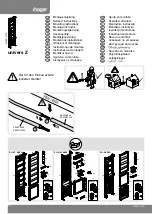
TROUBLESHOOTING AND REPAIR INSTRUCTIONS FOR L&L KILNS
troubleshoot-general.pdf
REV: 4/15/2017
Page 17
2017
L&L Kiln Mfg, Inc. 505 Sharptown Rd, Swedesboro NJ 08085 856.294.0077 F:856.294.0070 [email protected] hotkilns.com
code. Look for tC2’s temperature and write it down. It might
be
2175
. You have no cones in the kiln but you really
need these pieces fired.
Wait a few seconds until you see “
IdLE
,
tC2
,
2175
”.
Press
START
to re-start the program and note the time on
your watch. Note the 25 minutes the kiln was “holding” from
the last time you saw it at 2200°F until this time, where it
says
2175
. It must have continued to climb somewhat,
but because the
Err1
will appear after 22.5 minutes
of holding when the kiln is programmed to be climbing, it
probably never got over 2210°F. So the kiln has held at an
average of about 2195°F for about 25 minutes, instead of
continuing on to 2232°F (cone 6) to finish the firing.
The relationship between time and temperature allows you
to estimate how much hold time to add to get the same
amount of heat work as the kiln would have achieved by
climbing to 2232°F. Assuming a 108°F per hour temperature
rise, a good rule of thumb is to add about a 20 minute hold
to the maximum temperature; this will allow you to lower the
final temperature by about 20°F. An hour hold time would
mean a final temperature of about 40°F lower. A two hour
hold time would be about 60°F lower.
In this example, the kiln has already held at about 35
degrees lower than the final temperature for 25 minutes. It
would need another 25 minutes of holding to give the ware
the same amount of heat work that 2232°F (cone 6) would
have.
In reality, however, an Err1 that close to the end of a firing
probably means you need new elements. So re-starting
the kiln will probably not enable it to climb much higher in
temperature. Keeping track of the time, let it run, and when
it shows Err1 again just keep re-starting it until the firing
finishes. Meanwhile call and order new elements.
Be very careful if you try this method. On loads that are
very important always use cones you can see through the
peepholes in case of a failure of some kind. If you have to
use this method without the cones, remember that almost
all your calculations are based on estimates and the results
could be disastrous to your ware and/or the kiln if you are
not accurate enough. The further away the temperature
that the kiln is holding at is from the cone that the firing was
trying to get to, the less accurate an estimated amount of
time will be to achieve the amount of heat work necessary. If
you can wait and re-fire from room temperature, you should.
If you depend in any way on your kiln you should keep
spare parts around for it. You could replace the elements
easily yourself after the kiln cools and then re-load it and
re-fire it to the proper cone without losing much time at
all. Or consider that most glazes have an entire cone’s
temperature range that they can mature within. Weigh your
options and decide.
In general though, Error Codes mostly appear after the kiln
has been disassembled and set back up improperly, has
had its power supply altered (like moving to a new studio
with different voltage), or has had an element, a relay, or a
thermocouple burn out.
ONE-TOUCH ERROR MESSAGES
Error codes can appear at any time during the firing. They
always refer to a problem that, if allowed to continue, could
end with unknown or even disastrous results.
Errd
,
Err1
,
ErrP
and the
FAIL
message make the most
frequent appearances.
Errd
Error d indicates that the kiln temperature is 100°F above the
traveling set-point, which is the current desired temperature
in the kiln. The traveling set-point will increase or decrease
according to the programmed rate.
1) Something is too close to, or is touching the thermocouple.
Allow almost an inch between everything for thermal
expansion. Fix and re-fire the kiln.
2) The Thermocouple Lead Wire has melted against the kiln
case. The wire must be replaced.
3) The thermocouple is about to fail. Perform a physical
inspection, or just re-start the kiln and monitor it carefully.
4) Element(s) just burned out. Perform an ohms test for
more information.
5) The relay has just failed.
6) There is a bad connection point somewhere. This will
become more of a possibility as the kiln ages. Examine all
points carefully for melting, corrosion, and/or discoloration.
Err1
Error 1 indicates the temperature in the kiln is rising during
an up ramp slower than 15°F/hr. If this rate continues for
8 minutes the firing will be stopped.
Err1
may be an
indication that the elements are worn or that a relay has
stopped working.
1) If
Err1
is the error code on the screen when you
check on the firing, then for some reason the kiln could not
generate enough heat to counter the heat loss. If the kiln
can get no hotter (even though all the elements appear
to be on and the program is not holding), then
Err1
is
















































